Petrography and Geochemistry of the Leucocratic Rocks in the Ophiolites from the Pollino Massif (Southern Italy)
Abstract
:1. Introduction
2. Geological Framework and Field Relations
3. Materials and Methods
4. Results and Discussion
4.1. Petrography
4.2. Geochemistry
4.2.1. Major Elements
4.2.2. Trace Elements
4.3. Geochemical Features and Genetic Interpretation
4.4. Tectonic Setting
5. Conclusions
Author Contributions
Funding
Data Availability Statement
Acknowledgments
Conflicts of Interest
References
- Marien, C.S.; Hoffmann, J.E.; Garbe-Schönberg, C.D.; Münker, C. Petrogenesis of plagiogranites from the Troodos Ophiolite complex, Cyprus. Contrib. Mineral. Petrol. 2019, 174, 35. [Google Scholar]
- Beccaluva, L.; Chinchilla-Chaves, A.L.; Coltorti, M.; Giunta, G.; Sienna, F.; Vaccaro, C. Petrological and structural significance of the Santa Elena-Nicoya ophiolitic complex in Costa Rica and geodynamic implications. Eur. J. Mineral. 1999, 11, 1091–1107. [Google Scholar] [CrossRef]
- Floyd, R.A.; Göncüoğlu, M.C.; Winchester, J.A.; Yaliniz, M.K. Geochemical character and tectonic environment of Neotethyan ophiolitic fragments and metabasites in the Central Anatolian Crystalline Complex, Turkey. In Tectonics and Magmatism in Turkey and the Surrounding Area; Bozkurt, E., Winchester, J.A., Eds.; Geological Society of London Special Publications: London, UK, 2000; Volume 173, pp. 182–202. [Google Scholar]
- Niu, Y.; Gilmore, T.; Mackie, S.; Greig, A.; Bach, W. Mineral chemistry, whole-rock compositions, and petrogenesis of Leg 176 gabbros: Data and discussion. In Proceedings of ODP, Scientific Results; Natland, J.H., Dick, H.J.B., Miller, D.J., Von Herzen, R.P., Eds.; Ocean Drilling Program: College Station, TX, USA, 2002; pp. 1–60. [Google Scholar]
- Rao, D.R.; Rai, H.; Kumar, J.S. Origin of oceanic plagiogranite in the Nidar ophiolitic sequence of eastern Ladakh, Indıa. Curr. Sci. 2004, 87, 7. [Google Scholar]
- Berndt, J.; Koepke, J.; Holtz, F. An experimental investigation of the influence of water and oxygen fugacity on differentiation of MORB at 200 MPa. J. Petrol. 2005, 46, 135–167. [Google Scholar] [CrossRef] [Green Version]
- Dilek, Y.; Thy, P. Age and petrogenesis of plagiogranite intrusions in the Ankara mélange, central Turkey. Isl. Arc 2006, 15, 44–57. [Google Scholar] [CrossRef]
- Grimes, C.B.; Ushikubo, T.; Kozdon, R.; Valley, J.W. Perspectives on the origin of plagiogranite in ophiolites from oxygen isotopes in zircon. Lithos 2013, 179, 48–66. [Google Scholar] [CrossRef]
- Flagler, P.A.; Spray, J.G. Generation of plagiogranite by amphibolite anatexis in oceanic shear zones. Geology 1991, 19, 70–73. [Google Scholar] [CrossRef]
- Koepke, J.; Feig, S.T.; Snow, J.; Friese, M. Petrogenesis of oceanic plagiogranites by partial melting of gabbros: An experimental study. Contrib. Mineral. Petrol. 2004, 146, 414–432. [Google Scholar] [CrossRef]
- Koepke, J.; Berndt, J.; Feig, S.T.; Holtz, F. The formation of SiO2-rich melts within the deep oceanic crust by hydrous partial melting of gabbros. Contrib. Mineral. Petrol. 2007, 153, 67–84. [Google Scholar] [CrossRef]
- Brophy, J.G. La–SiO2 and Yb–SiO2 systematics in mid-ocean ridge magmas: Implications for the origin of oceanic plagiogranite. Contrib. Mineral. Petrol. 2009, 158, 99–111. [Google Scholar] [CrossRef]
- Brophy, J.G.; Pu, X. Rare earth element–SiO2 systematics of mid-ocean ridge plagiogranites and host gabbros from the Fournier oceanic fragment, New Brunswick, Canada: A field evaluation of some model predictions. Contrib. Mineral. Petrol. 2012, 164, 191–204. [Google Scholar] [CrossRef]
- Kiliç, A.D. Petrographical and geochemical properties of plagiogranites and gabbros in Guleman ophiolite. Maden Tetk. Aram. Derg. 2009, 139, 33–49. [Google Scholar]
- Castelli, D.; Lombardo, B. The Plagiogranite Fe-Ti-oxide gabbro association of Verne (Monviso metamorphic ophiolite, Western Alps). Ofioliti 2007, 32, 1–14. [Google Scholar]
- Borsi, L.; Schärer, U.; Gaggero, L.; Crispini, L. Age, origin and geodynamic significance of plagiogranites in lherzolites and gabbros of the Piedmont-Ligurian ocean basin. Earth Planet. Sci. Lett. 1996, 140, 227–241. [Google Scholar] [CrossRef]
- Montanini, A.; Travaglioli, M.; Serri, G.; Dostal, J.; Ricci, C.A. Petrology of gabbroic to plagiogranitic rocks from southern Tuscany (Italy): Evidence for magmatic differentation in an ophiolitic sequence. Ofioliti 2006, 31, 55–69. [Google Scholar]
- Köksal, S.; Toksoy-Köksal, F.; Göncüoglu, M. Petrogenesis and geodynamics of plagiogranites from Central Turkey (Ekecikdağ/Aksaray): New geochemical and isotopic data for generation in an arc basin system within the northern branch of Neotethys. Int. J. Earth Sci. 2017, 106, 1181–1203. [Google Scholar] [CrossRef]
- Milovanović, D.; Srećković-Batoćanin, D.; Savić, M.; Popovic, D. Petrology of plagiogranite from Sjenica, Dinaridic Ophiolite Belt (southwestern Serbia). Methods 2012, 126, 128. [Google Scholar] [CrossRef] [Green Version]
- Stakes, D.S.; Taylor, H.P. Magmatic, metamorphic and tectonic processes in ophiolite genesis: Oxygen isotope and chemical studies on the origin of large plagiogranite bodies in northern Oman, and their relationship to the overlying massive sulphide deposits. Geol. Soc. Lond. Spec. Publ. 2003, 218, 315–351. [Google Scholar] [CrossRef]
- Dilek, Y.; Furnes, H. Ophiolite genesis and global tectonics: Geochemical and tectonic fingerprinting of ancient oceanic lithosphere. GSA Bull. 2011, 123, 387–411. [Google Scholar] [CrossRef]
- Vezzani, L. La Formazione del Frido (NeocomianoAptiano) tra il Pollino ed il Sinni. Geol. Romana 1969, 8, 129–176. [Google Scholar]
- Bonardi, G.; Ciarcia, S.; Di Nocera, S.; Matano, F.; Sgrosso, I.; Torre, M. Carta delle principali unità cinematiche dell’Appennino meridionale. Nota Illustrativa. Boll. Della Soc. Geol. Ital. 2009, 128, 47–60. [Google Scholar]
- Monaco, C.; Tortorici, L.; Morten, L.; Critelli, S.; Tansi, C. Geologia del versante Nord Orientale del Massiccio del Pollino (Confine Calabro Lucano): Nota illustrativa sintetica alla scala 1:50,000. Boll. Soc. Geol. Ital. 1995, 114, 277–291. [Google Scholar]
- Monaco, C.; Tortorici, L. Tectonic role of ophiolite-bearing terranes in building of the Southern Apennines orogenic belt. Terra Nova 1995, 7, 153–160. [Google Scholar] [CrossRef]
- Vitale, S.; Fedele, L.; Tramparulo, F.; Ciarcia, S.; Mazzoli, S.; Novellino, A. Structural and petrological analyses of the Frido unit (southern Italy): New insights into the early tectonic evolution of the southern Apennines—Calabrian arc system. Lithos 2013, 168, 219–235. [Google Scholar] [CrossRef]
- Sansone, M.T.C.; Rizzo, G.; Mongelli, G. Petrochemical characterization of mafic rocks from the Ligurian ophiolites, southern Apennines. Int. Geol. Rev. 2011, 53, 130–156. [Google Scholar] [CrossRef]
- Sansone, M.T.C.; Tartarotti, P.; Prosser, G.; Rizzo, G. From ocean to subduction: The polyphase metamorphic evolution of the Frido Unit metadolerite dykes (Southern Appennine, Italy). In Multiscale Structural Analysis Devoted to the Reconstruction of Tectonic in Active Margins; Gosso, G., Spalla, M.I., Zucali, M., Eds.; The Virtual Explorer Pty Ltd: Clear Range, Australia, 2012; Volume 41, p. 3. ISSN 1441-8142. [Google Scholar]
- Sansone, M.T.C.; Rizzo, G. Pumpellyite veins in the metadolerite of the Frido unit (southern Apennines-Italy). Period Miner. 2012, 81, 75–92. [Google Scholar]
- Ciarcia, S.; Mazzoli, S.; Vitale, S.; Zattin, M. On the tectonic evolution of the Ligurian accretionary complex in southern Italy. GSA Bull 2012, 124, 463–483. [Google Scholar] [CrossRef]
- Knott, S.D. Structure, kinematics and metamorphism in the Liguride Complex, Southern Apennine, Italy. J. Struct. Geol. 1994, 16, 1107–1120. [Google Scholar] [CrossRef]
- Schiattarella, M. Tettonica della Catena del Pollino (confine Calabro-Lucano). Mem. Soc. Geol. Ital. 1996, 51, 543–566. [Google Scholar]
- Giano, S.I.; Gioia, D.; Schiattarella, M. Morphotectonic evolution of connected intermontane basins from the southern Apennines, Italy: The legacy of the pre-existing structurally controlled landscape. Rend. Lincei 2014, 25, 241–252. [Google Scholar] [CrossRef]
- Giano, S.I.; Giannandrea, P. Late Pleistocene differential uplift inferred from the analysis of fluvial terraces (southern Apennines, Italy). Geomorphology 2014, 217, 89–105. [Google Scholar] [CrossRef]
- Di Leo, P.; Schiattarella, M.; Cuadros, J.; Cullers, R. Clay mineralogy, geochemistry and structural setting of the ophiolite-bearing units from Southern Italy: A multidisciplinary approach to assess tectonics history and exhumation modalities. Atti Ticinensi Sci. Della Terra 2005, 10, 87–93. [Google Scholar]
- Laurita, S.; Prosser, G.; Rizzo, G.; Langone, A.; Tiepolo, M.; Laurita, A. Geochronological study of zircons from continental crust rocks in the Frido Unit (Southern Apennines). Int. J. Earth Sci. 2014, 104, 179–203. [Google Scholar] [CrossRef]
- Tortorici, L.; Catalano, S.; Monaco, C. Ophiolite-bearing mélanges in southern Italy. Geol. J. 2009, 44, 153–166. [Google Scholar] [CrossRef]
- Rizzo, G.; Sansone, M.T.C.; Perri, F.; Laurita, S. Mineralogy and petrology of the metasedimentary rocks from the Frido Unit (southern Apennines, Italy). Period. Mineral. 2016, 85, 153–168. [Google Scholar]
- Spadea, P. Contributo alla conoscenza dei metabasalti ofiolitici della Calabria Settentrionale e Centrale e dell’Appennino Lucano: Rendiconti della Società Italiana di Mineralogia Petrologia. Rend. Soc. Ital. Mineral. Petrol. 1979, 35, 251–276. [Google Scholar]
- Knott, S.D. The Liguride Complex of Southern Italy: A Cretaceous to Paleogene accretionary wedge. Tectonophysics 1987, 142, 217–226. [Google Scholar] [CrossRef]
- Bonardi, G.; Amore, F.O.; Ciampo, G.; De Capoa, P.; Miconnet, P. Il complesso Liguride Auct.: Stato delle conoscenze e problemi aperti dulla sur evoluzione pre-Appenninica ed i suoli rapporti con l’Arco Calabro. Mem. Della Soc. Geol. Ital. 1988, 41, 17–35. [Google Scholar]
- Rizzo, G.; Laurita, S.; Altenberger, U. The Timpa delle Murge ophiolitic gabbros, southern Apennines: Insights from petrology and geochemistry and consequences to the geodynamic setting. Period. Mineral. 2018, 87, 5–20. [Google Scholar]
- Beccaluva, L.; Macciotta, G.; Spadea, P. Petrology and geodynamic significance of the Calabria-Lucania ophiolites. Rend. Soc. Ital. Mineral. Petrol. 1982, 38, 973–987. [Google Scholar]
- Cavalcante, F.; Belviso, C.; Finizio, F.; Lettino, A.; Fiore, S. Carta geologica delle Unità Liguridi dell’area del Pollino (Basilicata): Nuovi dati geologici, mineralogici e petrografici. In Regione Basilicata—Dip. Ambiente, Territorio e Politiche della Sostenibilità; Progetto grafico ed editoriale a cura di digilabs: Potenza, Italy, 2009; 36p. [Google Scholar]
- Coleman, R.G.; Donato, M.M. Oceanic plagiogranite revised. In Trondhjemites, Dacites, and Related Rocks. Development in Petrology; Barker, F., Ed.; Elesevier Scientifics Publication Corporation: New York, NY, USA, 1979; Volume 6, pp. 149–168. [Google Scholar]
- Schwartz, J.; Barbara, J.; Cheadle, M.J.; Miranda, E.A.; Grimes, C.B.; Wooden, J.L.; Dick, H.J.B. Dating the Growth of Oceanic Crust at a Slow-Spreading Ridge. Science 2005, 310, 654–657. [Google Scholar] [CrossRef] [PubMed] [Green Version]
- Warren, C.J.; Parrish, R.R.; Waters, D.J.; Searle, M.P. Dating the geologic history of Oman's Semail Ophiolite: Insights from U–Pb geochronology. Contrib. Mineral. Petrol. 2005, 150, 403–422. [Google Scholar] [CrossRef]
- Barker, F. Trondhjemite: Definition, environment, and hypotheses of origin. In Trondhjemites, Dacites, and Related Rocks; Barker, F., Ed.; Elsevier: Amsterdam, The Netherlands, 1979; pp. 1–12. [Google Scholar]
- Le Maitre, R.W. A classification of igneous rocks and glossary of terms. In Recommendations of the International Union of Geological Sciences Subcommission on the Systematics of Igneous Rocks; Cambridge University Press & Assessment: Cambridge, UK, 1989; Volume 193. [Google Scholar]
- O’connor, J.T. A classification for quartz-rich igneous rocks. Geol. Surv. Prof. Pap. 1965, 525, 79. [Google Scholar]
- Hatzipanagiotou, K.; Tsikouras, B. Plagiogranites in the Hellenic ophiolites. Ofioliti 1999, 24, 283–292. [Google Scholar]
- Silantyev, S.A.; Aranovich, L.Y.; Bortnikov, N.S. Oceanic plagiogranites as a result of interaction between magmatic and hydrothermal systems in the slow-spreading mid-ocean ridges. Petrology 2010, 18, 369–383. [Google Scholar] [CrossRef]
- Majer, V.; Garasic, V. Plagiogranites from the ophiolite complexes of Dinarides and Vardar zone. Rud.-Geol.-Naft. Zb. 2001, 13, 1. [Google Scholar]
- Irvine, T.N.; Baragar, W.R.A. A guide to the chemical classification of the common volcanic rocks. Can. J. Earth Sci. 1971, 8, 523–548. [Google Scholar] [CrossRef]
- Miyashiro, A. Volcanic rock series in island arcs and active continental margins. Am. J. Sci. 1974, 274, 321–355. [Google Scholar] [CrossRef]
- Coleman, R.G.; Peterman, Z.E. Oceanic plagiogranite. J. Geophys. Res. 1975, 80, 1099–1108. [Google Scholar] [CrossRef]
- Pearce, J.A.; Harris, N.B.; Tindle, A.G. Trace element discrimination diagrams for the tectonic interpretation of granitic rocks. J. Petrol. 1984, 25, 956–983. [Google Scholar] [CrossRef] [Green Version]
- Jöns, N.; Bach, W.; Schroeder, T. Formation and alteration of plagiogranites in an ultramafic-hosted detachment fault at the Mid-Atlantic Ridge (ODP Leg 209). Contrib. Mineral. Petrol. 2009, 157, 625. [Google Scholar] [CrossRef]
- Yaliniz, M.K.; Göncüoğlu, M.C.; Özkan-Altiner, S. Formation and emplacement ages of the SSZ-type Neotethyan ophiolites in central Anatolia, Turkey: Palaeotectonic implications. Geol. J. 2000, 35, 53–68. [Google Scholar] [CrossRef]
- McDonough, W.F.; Sun, S.S. The composition of the Earth. Chem. Geol. 1995, 120, 223–253. [Google Scholar] [CrossRef]
- Aldiss, D.T. Plagiogranites from the ocean crust and ophiolites. Nature 1981, 289, 577–578. [Google Scholar] [CrossRef]
- Dylek, Y.; Furnes, H. Structure and geochemistry of Tethyan ophiolites and their petrogenesis in subduction rollback systems. Lithos 2009, 113, 1–20. [Google Scholar] [CrossRef]
- Davidson, J.P. Deciphering mantle and crustal signatures in subduction zone magmatism. In Subduction: Top to Bottom; Bebout, G.E., Scholl, D.W., Kirby, S.H., Platteds, J.P., Eds.; AGU: Washington, DC, USA, 1996; Volume 96, pp. 251–262. [Google Scholar]
- Thirlwall, M.F.; Graham, A.M.; Arculus, R.J.; Harmon, R.S.; Macpherson, C.G. Resolution of the effects of crustal assimilation, sediment subduction, and fluid transport in island arc magmas: Pb Sr Nd O isotope geochemistry of Grenada, Lesser Antilles. Geochim. Cosmochim. Acta 1996, 60, 4785–4810. [Google Scholar] [CrossRef]
- Wood, D.A.; Joron, J.L.; Treuil, M. A re-appraisal of the use of trace elements to classify and discriminate between magma series erupted in different tectonic settings. Earth Planet. Sci. Lett. 1979, 45, 326–336. [Google Scholar] [CrossRef]
- Pearce, J.A.; Bender, J.F.; De Long, S.E.; Kidd, W.S.F.; Low, P.J.; Güner, Y.; Saroglu, F.; Yilmaz, Y.; Moorbath, S.; Mitchell, J.G. Genesis of collision volcanism in Eastern Anatolia, Turkey. J. Volcanol. Geotherm. Res. 1990, 44, 189–229. [Google Scholar] [CrossRef]
- Edwards, C.; Menzies, M.; Thirlwall, M. Evidence from Muriah, Indonesia, for the interplay of supra-subduction zone and intraplate processes in the genesis of potassic alkaline magmas. J. Petrol. 1991, 32, 555–592. [Google Scholar] [CrossRef]
- Pearce, J.A. Trace element characteristics of lavas from destructive plate boundaries. Andesites 1982, 8, 525–548. [Google Scholar]
- Hawkesworth, C.J.; O'nions, R.K.; Pankhurst, R.J.; Hamilton, P.J.; Evensen, N.M. A geochemical study of island-arc and back-arc tholeiites from the Scotia Sea. Earth Planet. Sci. Lett. 1977, 36, 253–262. [Google Scholar] [CrossRef]
- Jiang, Y.H.; Liao, S.Y.; Yang, W.Z.; Shen, W.Z. An island arc origin of plagiogranites at Oytag, western Kunlun orogen, northwest China: SHRIMP zircon U-Pb chronology, elemental and Sr-Nd-Hf isotopic geochemistry, and Paleozoic tectonic implications. Lithos 2008, 106, 323–335. [Google Scholar] [CrossRef]
- Calderón, M.; Hervé, F.; Cordaní, U.; Massonne, H.J. Crust-mantle interactions and generation of silicic melts: Insights from the Sarmiento Complex, southern Patagonian Andes. Rev. Geol. Chile 2007, 34, 249–275. [Google Scholar] [CrossRef]

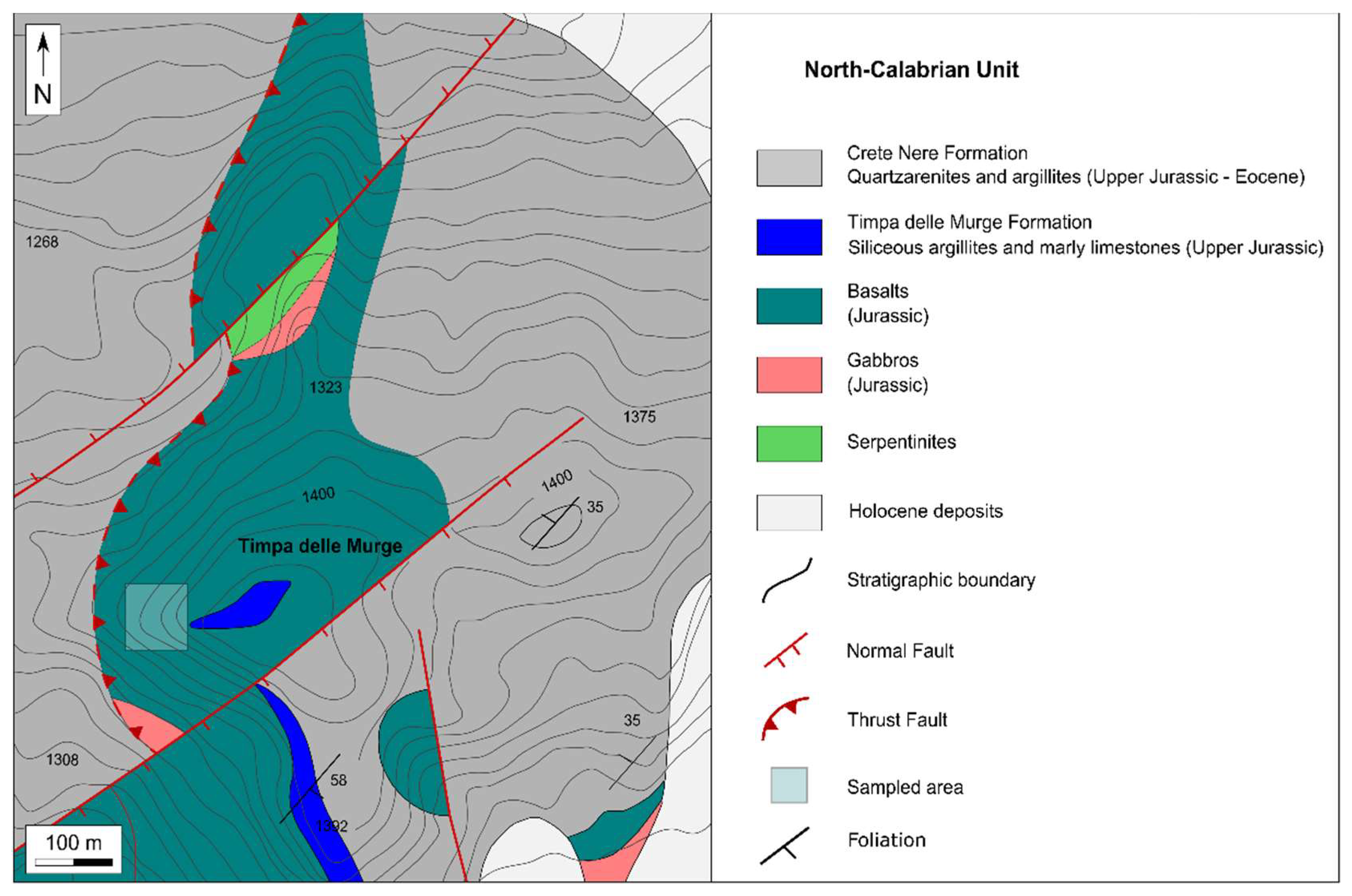

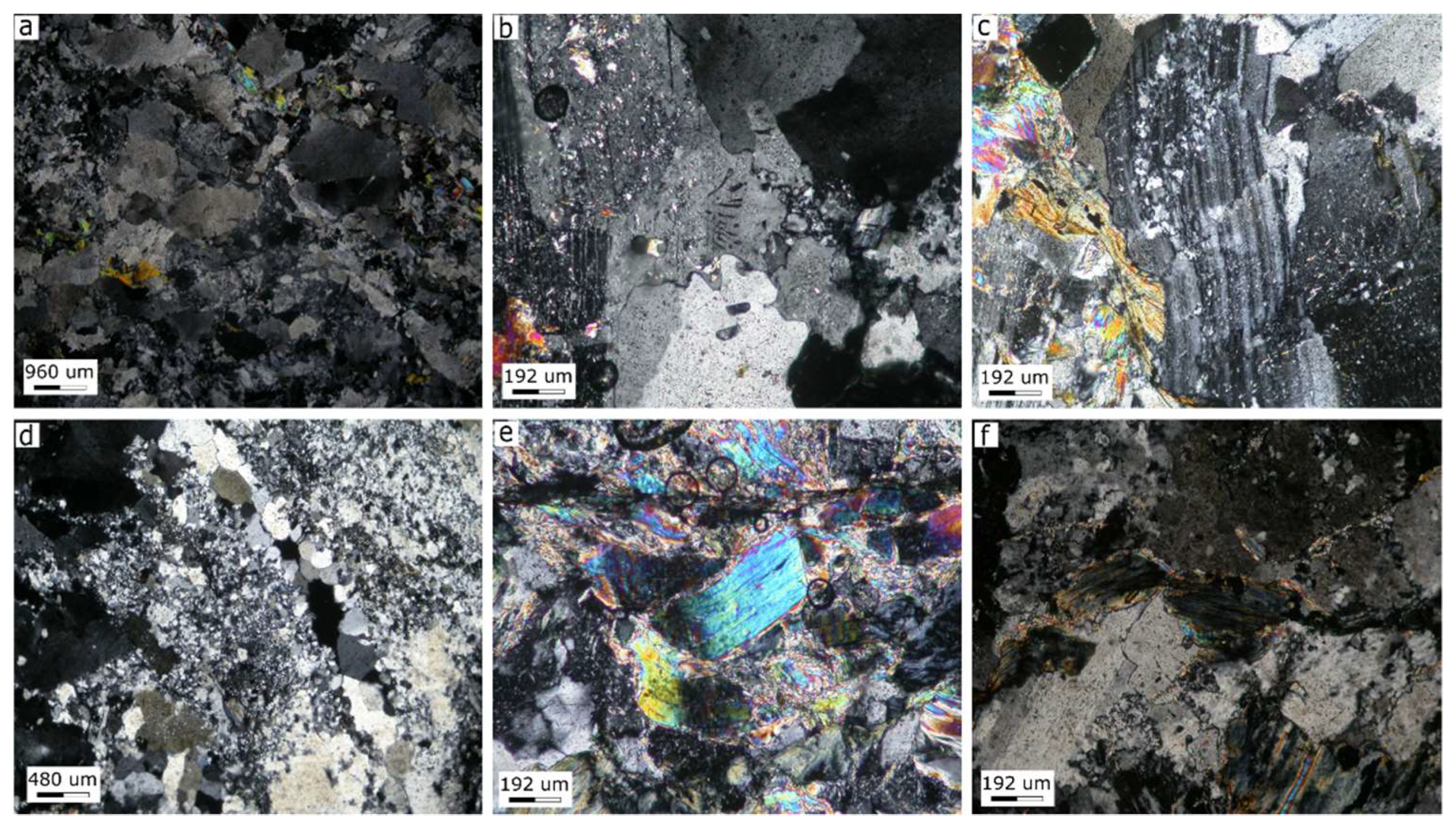

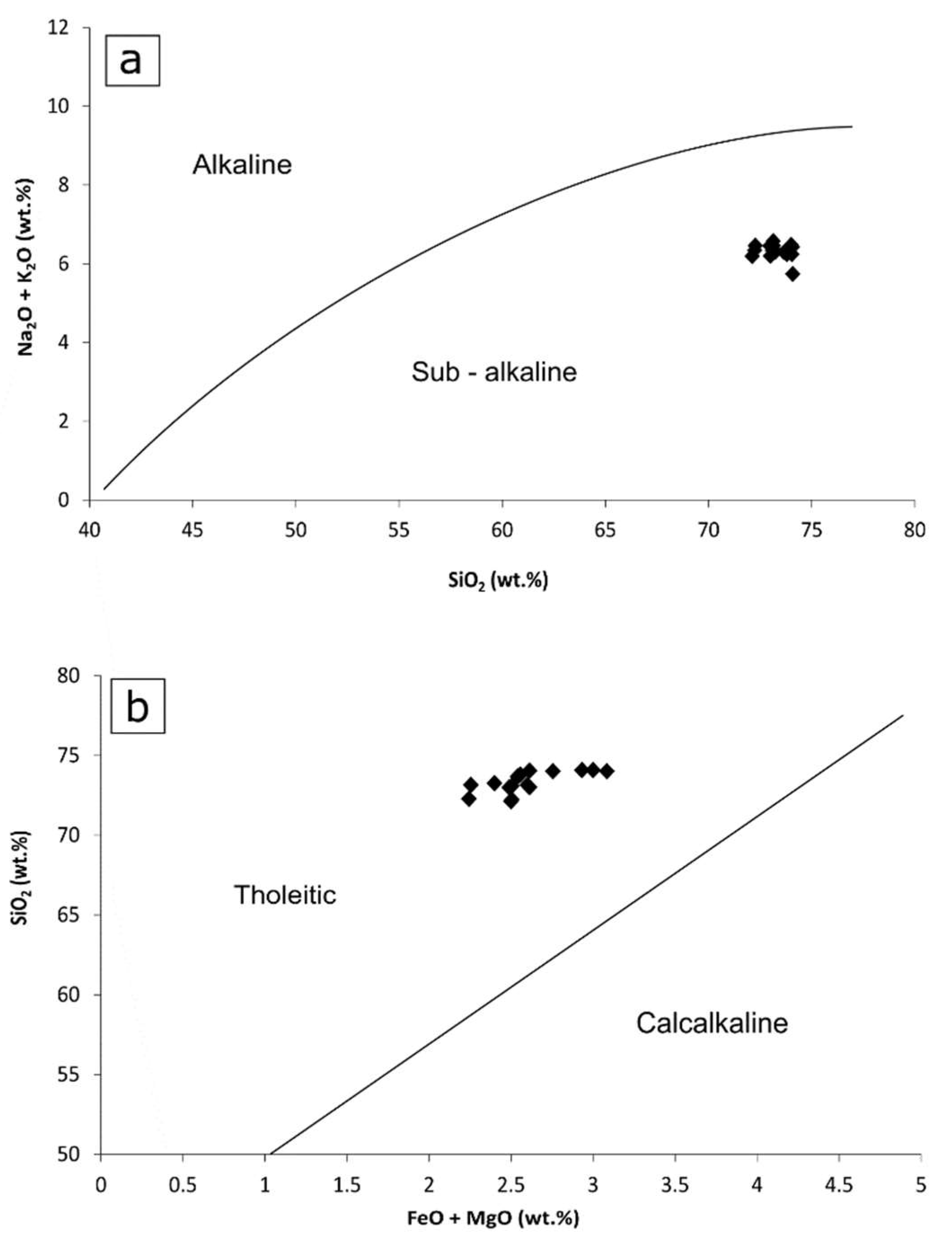
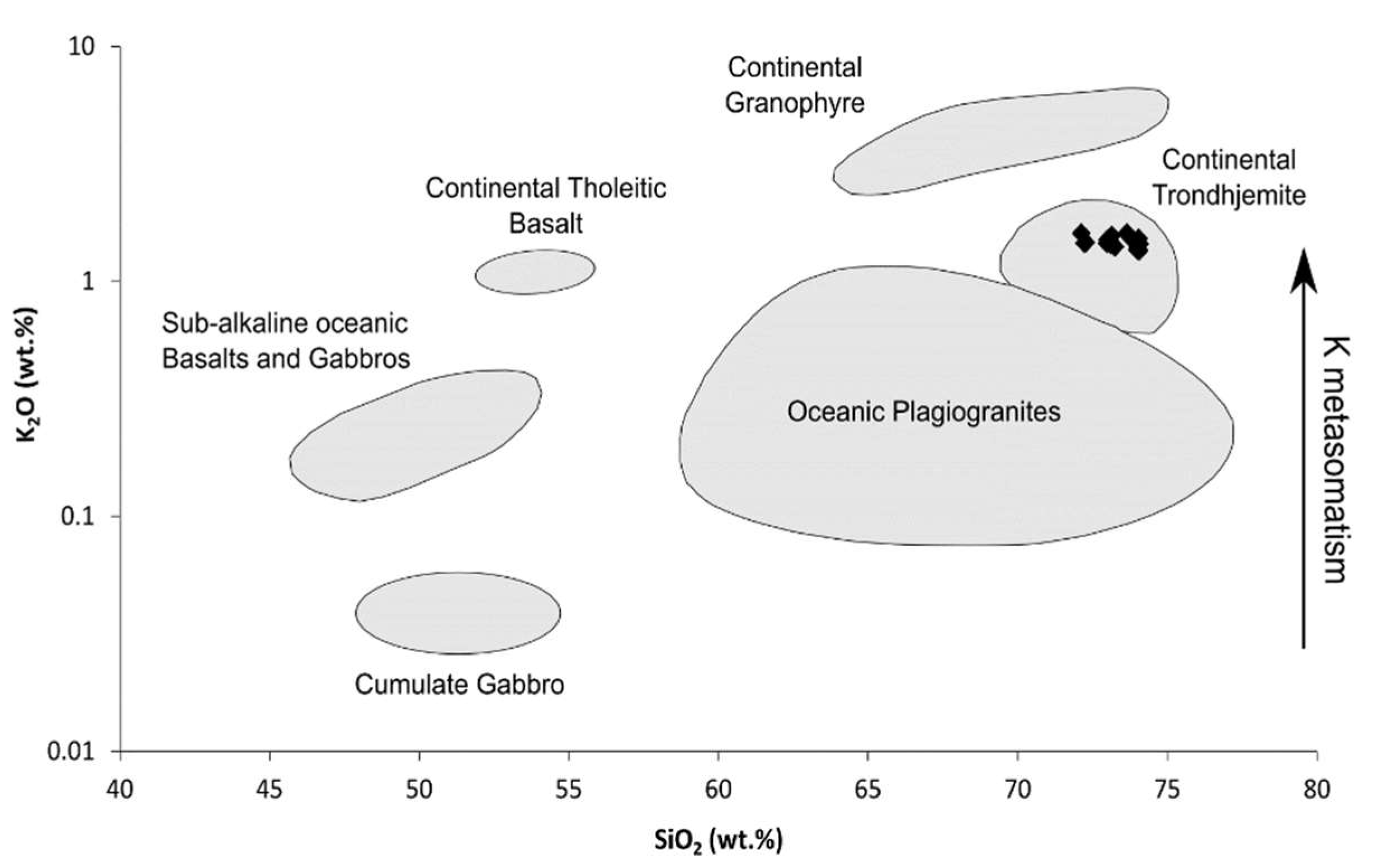
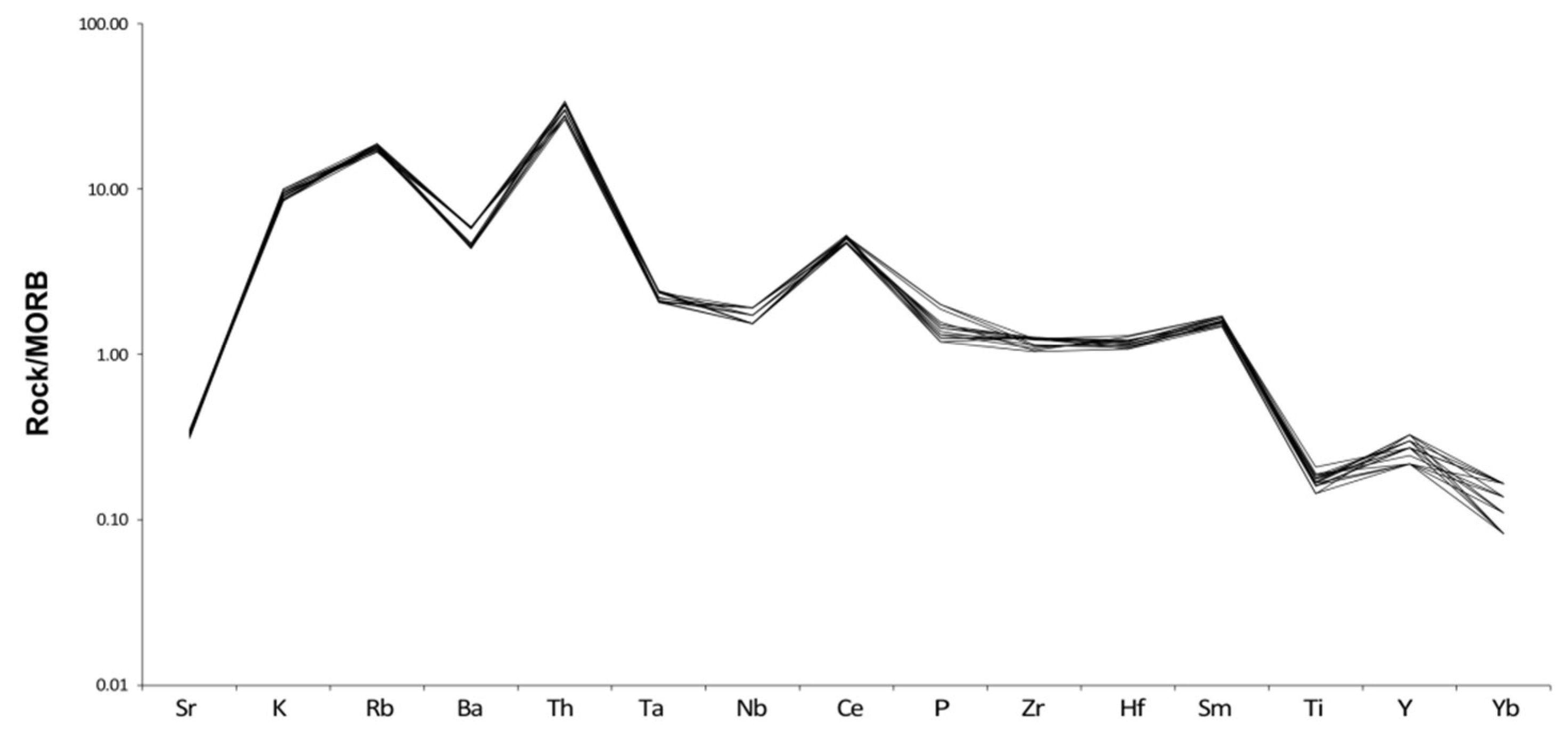
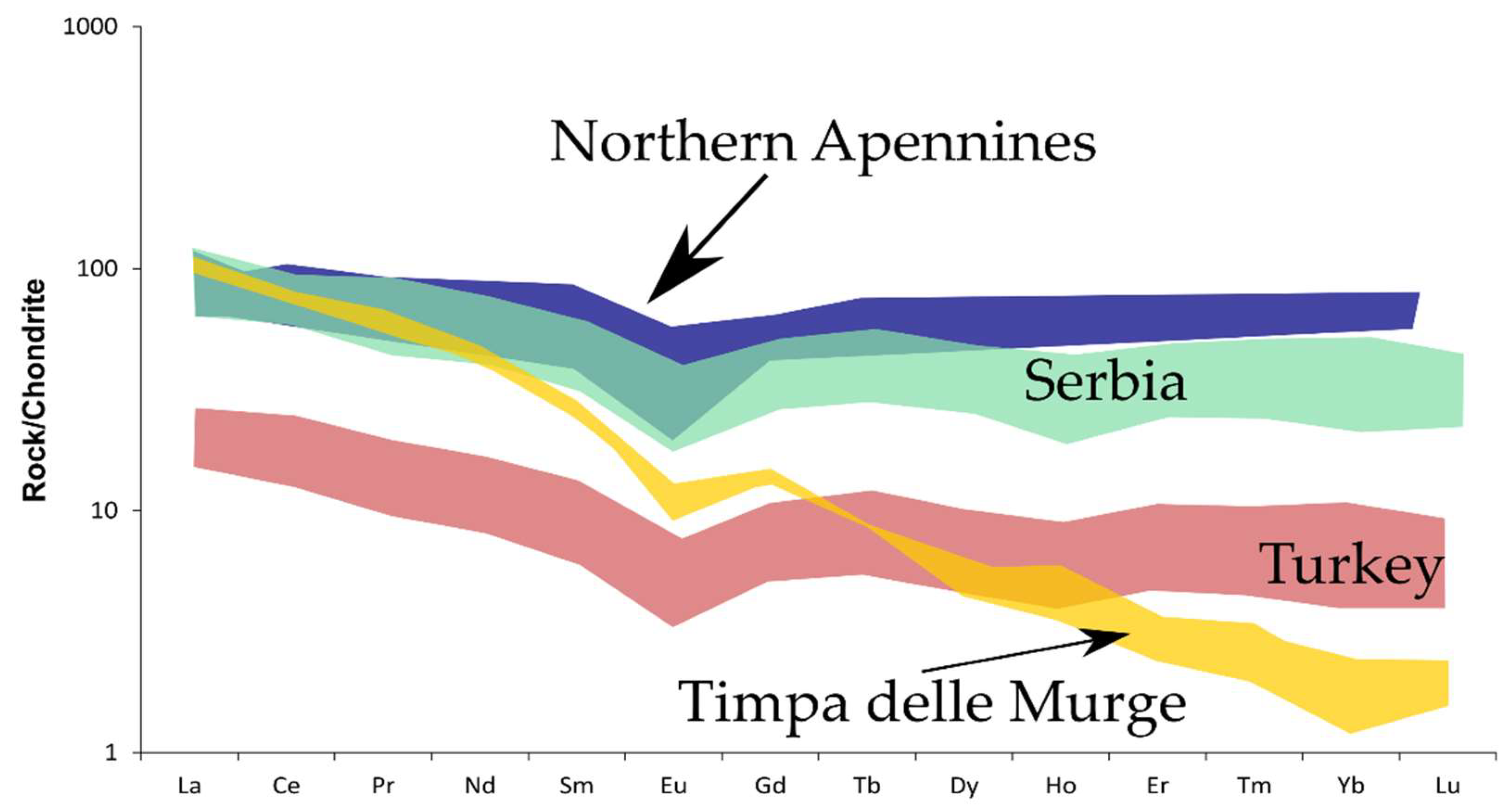
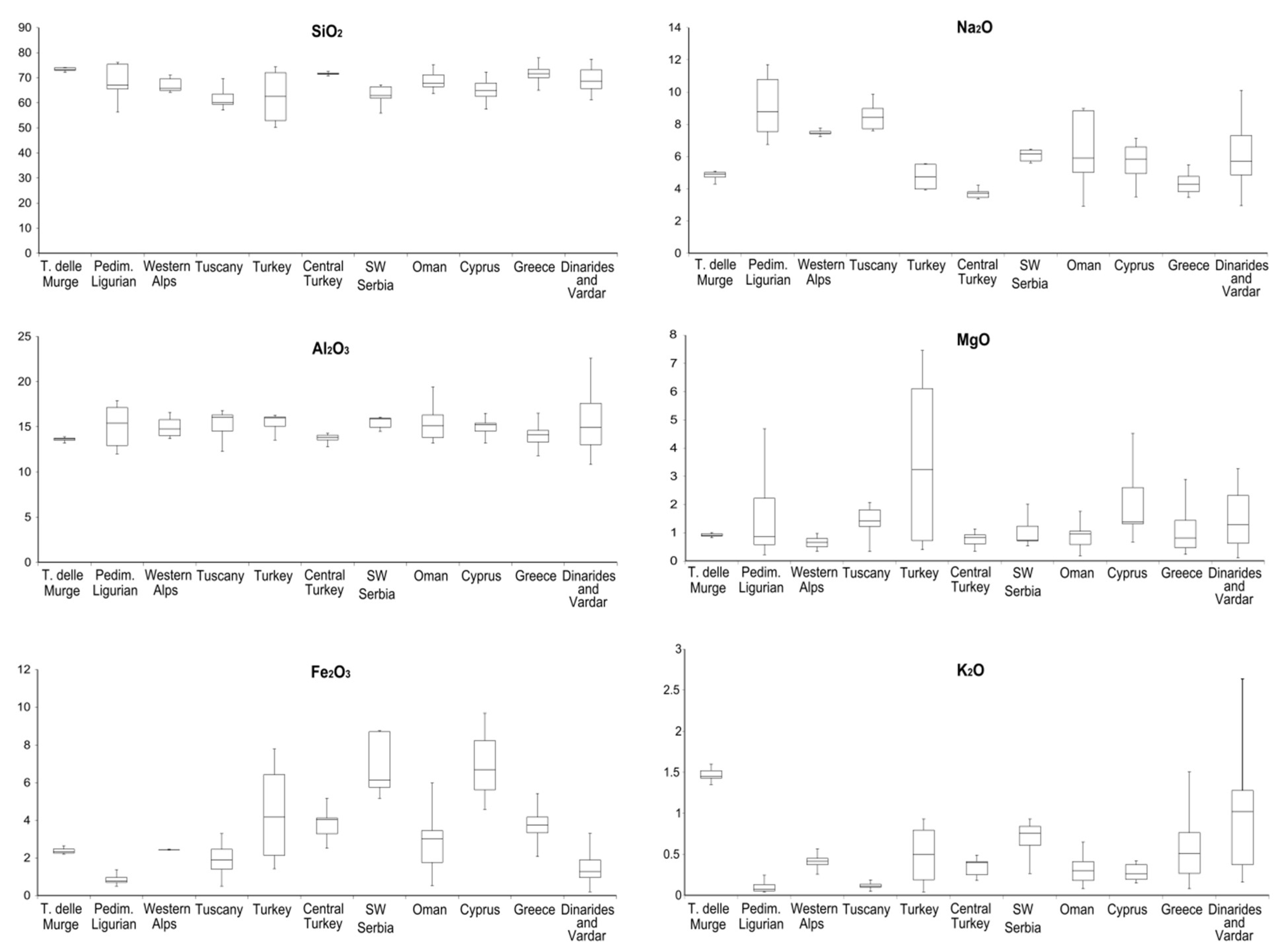
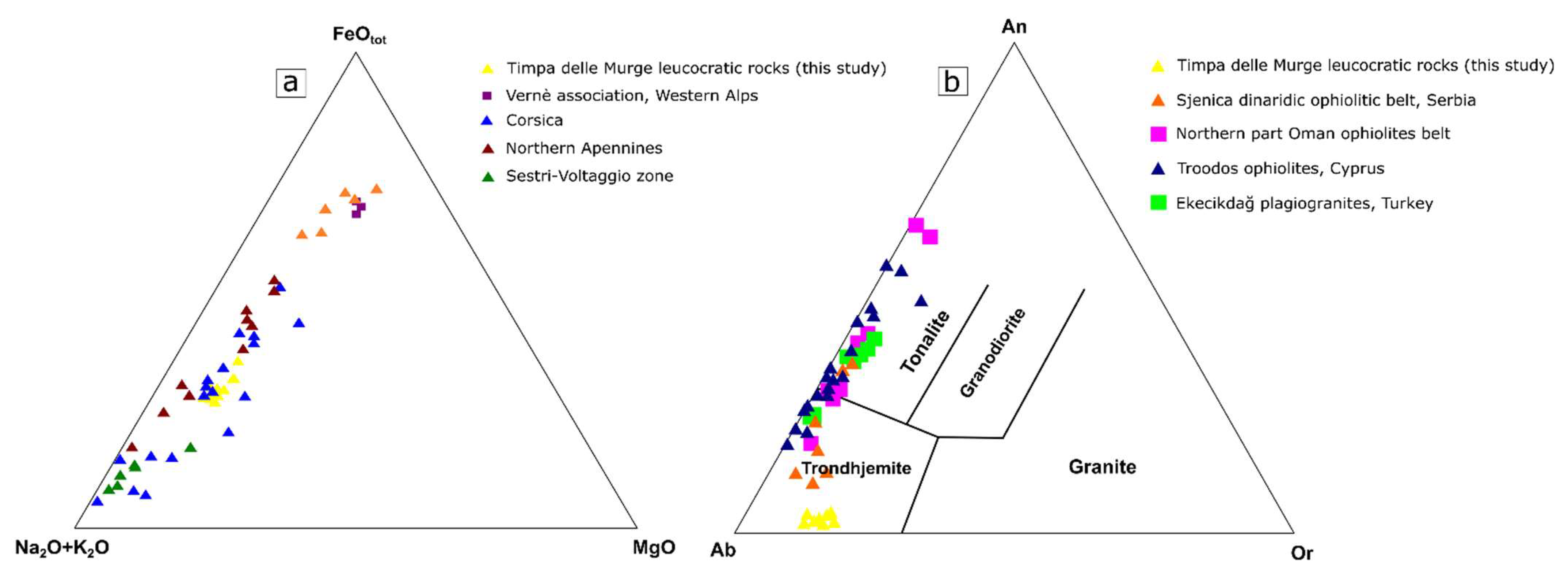
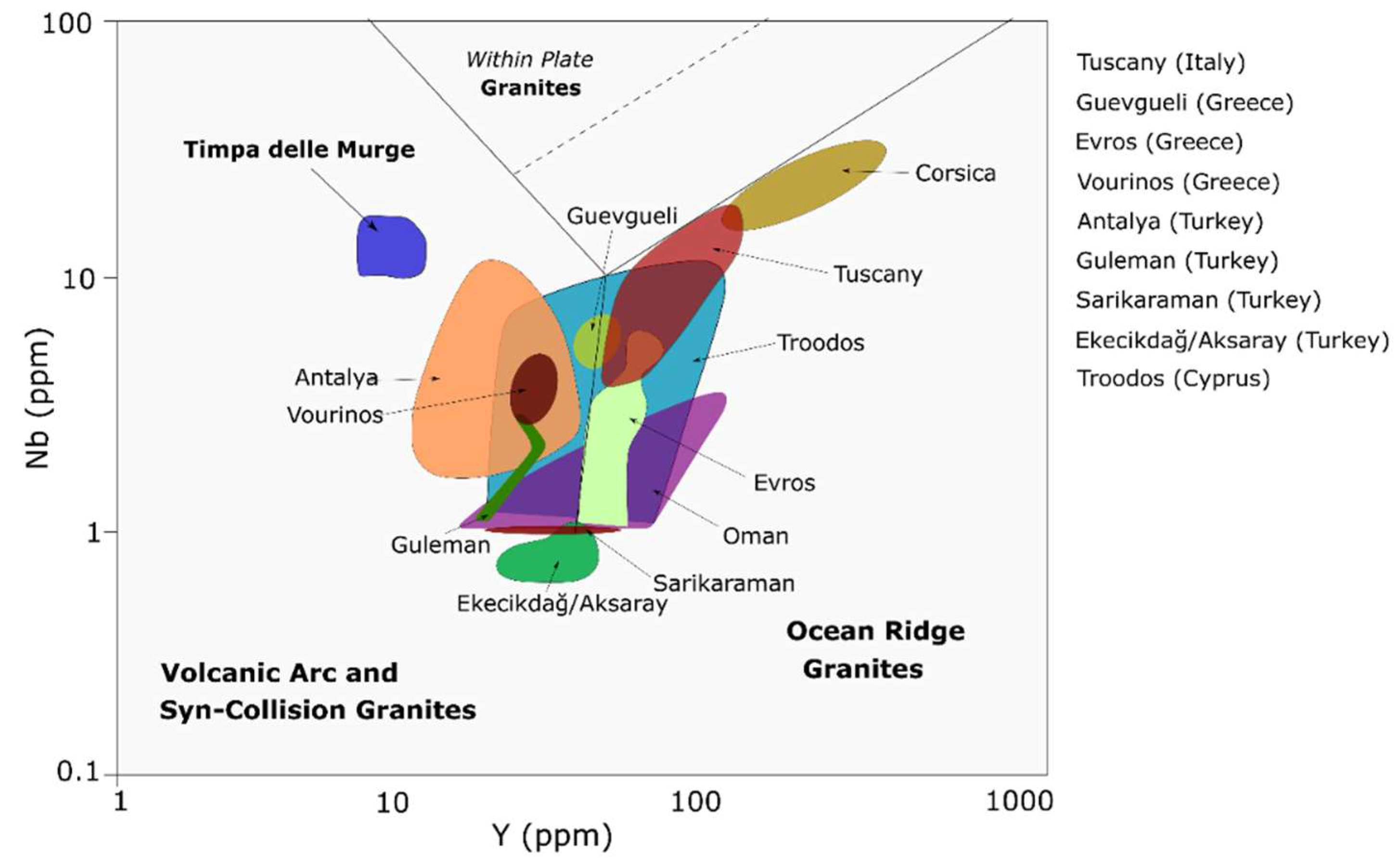

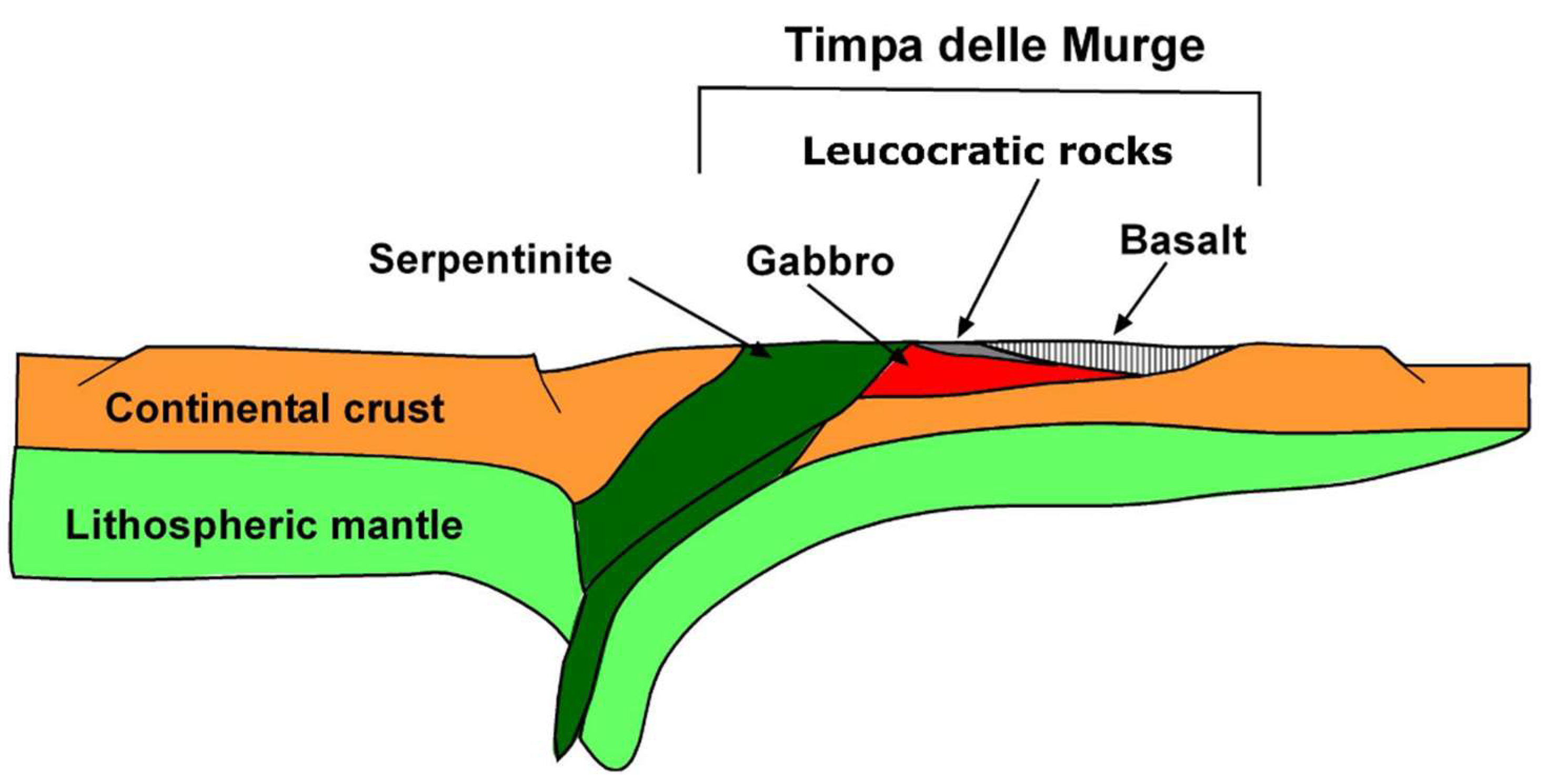
| Element | d.l. | PL 1 | PL 2 | PL 3 | PL 4 | PL 5 | PL 6 | PL 7 | PL 8 | PL 9 | PL 10 | PL 11 | PL 12 | PL 13 | PL 14 | PL 15 | PL 16 |
|---|---|---|---|---|---|---|---|---|---|---|---|---|---|---|---|---|---|
| % | |||||||||||||||||
| SiO2 | 0.01 | 74.00 | 72.98 | 73.00 | 73.25 | 72.28 | 72.13 | 74.01 | 73.15 | 74.05 | 72.24 | 73.15 | 73.66 | 74.07 | 74.08 | 73.80 | 73.10 |
| Al2O3 | 0.01 | 13.69 | 13.62 | 13.80 | 13.20 | 13.73 | 13.53 | 13.75 | 13.60 | 13.71 | 13.80 | 13.89 | 13.50 | 13.41 | 13.72 | 13.53 | 13.44 |
| MnO | 0.00 | 0.03 | 0.03 | 0.03 | 0.03 | 0.03 | 0.03 | 0.03 | 0.03 | 0.03 | 0.03 | 0.03 | 0.03 | 0.03 | 0.03 | 0.03 | 0.03 |
| MgO | 0.01 | 0.82 | 0.90 | 0.88 | 0.95 | 0.98 | 1.00 | 0.82 | 0.90 | 0.88 | 0.95 | 0.98 | 1.00 | 0.82 | 0.90 | 0.88 | 0.95 |
| CaO | 0.01 | 0.43 | 0.44 | 0.37 | 0.39 | 0.34 | 0.43 | 0.42 | 0.44 | 0.36 | 0.40 | 0,.34 | 0.42 | 0.43 | 0.44 | 0.38 | 0.39 |
| Na2O | 0.01 | 5.08 | 5.00 | 4.70 | 4.90 | 5.00 | 4.59 | 5.10 | 5.02 | 4.72 | 4.89 | 5.01 | 4.69 | 5.07 | 4.30 | 4.72 | 4.90 |
| K2O | 0.01 | 1.36 | 1.45 | 1.50 | 1.40 | 1.46 | 1.60 | 1.38 | 1.44 | 1.52 | 1.45 | 1.56 | 1.60 | 1.35 | 1.44 | 1.52 | 1.44 |
| TiO2 | 0.00 | 0.32 | 0.30 | 0.28 | 0.28 | 0.24 | 0.30 | 0.31 | 0.30 | 0.27 | 0.28 | 0.24 | 0.29 | 0.35 | 0.31 | 0.27 | 0.27 |
| P2O5 | 0.01 | 0.24 | 0.20 | 0.30 | 0.20 | 0.19 | 0.20 | 0.23 | 0.21 | 0.32 | 0.21 | 0.19 | 0.25 | 0.24 | 0.22 | 0.32 | 0.23 |
| LOI | - | 1.72 | 1.75 | 1.74 | 1.90 | 1.89 | 2.10 | 1.20 | 1.74 | 1.84 | 1.92 | 1.88 | 1.12 | 1.77 | 1.85 | 1.76 | 1.91 |
| TOTAL | - | 99.97 | 99.35 | 99.54 | 99.60 | 98.34 | 98.40 | 99.78 | 99.17 | 99.99 | 98.55 | 99.48 | 100.09 | 99.99 | 99.93 | 99.46 | 99.04 |
| ppm | |||||||||||||||||
| V | 5 | 19 | 18 | 17 | 19 | 16 | 18 | 18 | 17 | 19 | 19 | 16 | 18 | 16 | 17 | 18 | 17 |
| Ba | 3 | 135 | 137 | 168 | 130 | 128 | 171 | 172 | 167 | 134 | 131 | 128 | 170 | 127 | 169 | 172 | 170 |
| Sr | 2 | 45 | 43 | 41 | 44 | 42 | 44 | 43 | 41 | 45 | 42 | 43 | 44 | 43 | 41 | 40 | 43 |
| Y | 2 | 8 | 10 | 11 | 8 | 12 | 10 | 9 | 11 | 10 | 12 | 8 | 12 | 10 | 11 | 8 | 10 |
| Zr | 4 | 147 | 145 | 130 | 147 | 121 | 144 | 148 | 146 | 133 | 127 | 147 | 123 | 145 | 132 | 145 | 142 |
| Cr | 20 | 190 | 230 | 260 | 200 | 260 | 280 | 191 | 220 | 250 | 270 | 254 | 232 | 195 | 281 | 264 | 190 |
| Co | 1 | 4 | 4 | 4 | 5 | 4 | 5 | 5 | 5 | 4 | 4 | 4 | 5 | 4 | 5 | 5 | 4 |
| Zn | 30 | 50 | 50 | 40 | 40 | 40 | 50 | 50 | 50 | 40 | 40 | 40 | 50 | 50 | 40 | 50 | 40 |
| Ga | 1 | 17 | 16 | 17 | 17 | 16 | 17 | 17 | 16 | 16 | 17 | 16 | 16 | 17 | 17 | 16 | 17 |
| Rb | 2 | 49 | 50 | 50 | 51 | 52 | 54 | 52 | 53 | 53 | 50 | 50 | 51 | 54 | 54 | 48 | 50 |
| Nb | 1 | 8 | 8 | 10 | 9 | 8 | 10 | 10 | 8 | 8 | 9 | 8 | 9 | 8 | 10 | 10 | 8 |
| Ta | 0.1 | 0.8 | 0.82 | 0.8 | 0.75 | 0.7 | 0.7 | 0.71 | 0.8 | 0.81 | 0.72 | 0.81 | 0.82 | 0.81 | 0.74 | 0.7 | 0.71 |
| Pb | 5 | 13 | 14 | 12 | 15 | 10 | 16 | 15 | 16 | 10 | 12 | 14 | 12 | 13 | 11 | 14 | 14 |
| La | 0.1 | 38.2 | 40 | 37 | 39 | 35.8 | 40.4 | 35.7 | 36.4 | 39 | 40 | 38 | 39.2 | 37.5 | 38.6 | 40.05 | 37 |
| Ce | 0.1 | 73.8 | 77 | 75 | 70 | 69.4 | 78 | 70 | 74 | 77 | 75 | 75 | 69.5 | 70 | 71 | 76 | 75 |
| Pr | 0.05 | 8.37 | 9.2 | 8.5 | 8 | 7.5 | 8.68 | 9.1 | 8.4 | 7.7 | 7.5 | 8.7 | 8.1 | 9.1 | 9.15 | 8.3 | 9.2 |
| Nd | 0.1 | 32.9 | 33 | 29 | 32 | 29.8 | 33.8 | 32.7 | 32.8 | 33.15 | 29.2 | 32 | 29.65 | 33.7 | 28.8 | 29.9 | 30.1 |
| Sm | 0.1 | 6.5 | 6 | 6.3 | 5.9 | 5.6 | 6.5 | 6.05 | 5.87 | 6 | 5.9 | 5.7 | 6.5 | 6.35 | 6.12 | 6.3 | 5.7 |
| Eu | 0.05 | 0.8 | 1 | 0.98 | 0.99 | 1.01 | 1.08 | 0.97 | 0.99 | 0.99 | 0.99 | 1.01 | 0.85 | 1.04 | 0.97 | 0.99 | 1.11 |
| Gd | 0.1 | 4.1 | 4.2 | 4 | 4.3 | 4 | 4.5 | 4 | 4.2 | 4.05 | 4.51 | 4.12 | 4.43 | 4.15 | 4.31 | 4.1 | 4.4 |
| Tb | 0.1 | 0.5 | 0.5 | 0.5 | 0.5 | 0.5 | 0.5 | 0.5 | 0.5 | 0.5 | 0.5 | 0.5 | 0.5 | 0.5 | 0.5 | 0.5 | 0.5 |
| Dy | 0.1 | 1.7 | 2 | 2.2 | 2.3 | 2.3 | 2.4 | 2.4 | 1.8 | 2.2 | 2.4 | 2.3 | 2.3 | 2.3 | 1.7 | 1.9 | 1.9 |
| Ho | 0.1 | 0.3 | 0.3 | 0.4 | 0.4 | 0.4 | 0.4 | 0.4 | 0.3 | 0.5 | 0.4 | 0.4 | 0.4 | 0.3 | 0.3 | 0.5 | 0.5 |
| Er | 0.1 | 0.6 | 0.7 | 0.6 | 0.8 | 0.9 | 0.8 | 0.7 | 0.8 | 0.7 | 0.6 | 0.6 | 0.9 | 0.9 | 0.8 | 0.8 | 0.9 |
| Tm | 0.05 | 0.07 | 0.08 | 0.09 | 0.07 | 0.11 | 0.1 | 0.08 | 0.09 | 0.09 | 0.08 | 0.11 | 0.12 | 0.12 | 0.09 | 0.08 | 0.07 |
| Yb | 0.1 | 0.4 | 0.3 | 0.6 | 0.3 | 0.6 | 0.6 | 0.5 | 0.4 | 0.6 | 0.3 | 0.5 | 0.5 | 0.4 | 0.3 | 0.6 | 0.6 |
| Lu | 0.04 | 0.06 | 0.06 | 0.09 | 0.08 | 0.09 | 0.09 | 0.06 | 0.06 | 0.08 | 0.08 | 0.08 | 0.09 | 0.09 | 0.08 | 0.08 | 0.06 |
| Ce/Ce* | - | 0.97 | 0.94 | 0.99 | 0.93 | 0.99 | 0.98 | 0.91 | 0.99 | 1.04 | 1.01 | 0.97 | 0.91 | 0.89 | 0.89 | 0.98 | 0.95 |
| Eu/Eu* | - | 0.47 | 0.61 | 0.60 | 0.60 | 0.65 | 0.61 | 0.60 | 0.61 | 0.61 | 0.59 | 0.64 | 0.48 | 0.62 | 0.58 | 0.60 | 0.68 |
| (La/Yb)ch | - | 64.53 | 90.10 | 41.67 | 87.85 | 40.32 | 45.50 | 48.25 | 61.49 | 43.92 | 90.10 | 51.36 | 52.98 | 63.35 | 86.95 | 45.11 | 41.67 |
| (Gd/Yb)ch | - | 8.31 | 11.35 | 5.40 | 11.62 | 5.40 | 6.08 | 6.48 | 8.51 | 5.47 | 12.18 | 6.68 | 7.18 | 8.41 | 11.64 | 5.54 | 5.94 |
Publisher’s Note: MDPI stays neutral with regard to jurisdictional claims in published maps and institutional affiliations. |
© 2021 by the authors. Licensee MDPI, Basel, Switzerland. This article is an open access article distributed under the terms and conditions of the Creative Commons Attribution (CC BY) license (https://creativecommons.org/licenses/by/4.0/).
Share and Cite
Rizzo, G.; Buccione, R.; Paternoster, M.; Laurita, S.; Bloise, L.; Calabrese, E.; Sinisi, R.; Mongelli, G. Petrography and Geochemistry of the Leucocratic Rocks in the Ophiolites from the Pollino Massif (Southern Italy). Minerals 2021, 11, 1264. https://doi.org/10.3390/min11111264
Rizzo G, Buccione R, Paternoster M, Laurita S, Bloise L, Calabrese E, Sinisi R, Mongelli G. Petrography and Geochemistry of the Leucocratic Rocks in the Ophiolites from the Pollino Massif (Southern Italy). Minerals. 2021; 11(11):1264. https://doi.org/10.3390/min11111264
Chicago/Turabian StyleRizzo, Giovanna, Roberto Buccione, Michele Paternoster, Salvatore Laurita, Luigi Bloise, Egidio Calabrese, Rosa Sinisi, and Giovanni Mongelli. 2021. "Petrography and Geochemistry of the Leucocratic Rocks in the Ophiolites from the Pollino Massif (Southern Italy)" Minerals 11, no. 11: 1264. https://doi.org/10.3390/min11111264








